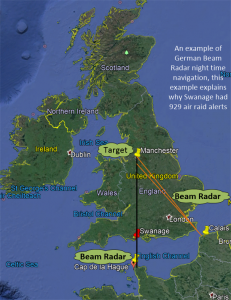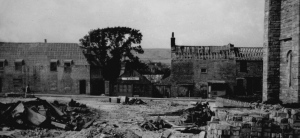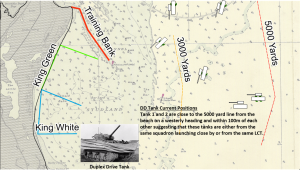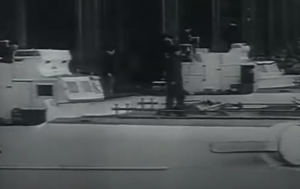Swanage Air Raids 1942-3
Exercise Smash 4 April 1944
In 1942, Swanage had five air raids carried out by light bombers such as the Junkers Ju 87 Stuka and Messerschmitt Bf 109 fighter. The first one was on the 20 April, where houses in Cornwall Road were damaged killing five people and injuring 21 people. The next event was on 13 July, where houses in Park Road were damaged resulting in three causalities. The next event was on 14 May, where a bomb landed west of the town hall seriously damaging John Wesley’s cottage. The next event was on the 17 August.
The adjacent Videos explain the design of the Duplex Drive Tank used in Operation Smash and provides images of Studland bay, including Fort Henry and the associated American Exercise at Slapdown Sands Devon.
The American Exercise Tiger 27 April 1944 on Slapdown Sands Devon
It was around 0200 hours when the German E- boat attack began. As the eight American LSTs lumbered toward the coast, their crews were startled by an eruption of gunfire and the flash of tracer rounds in the night sky. One American sergeant stated “All hell broke loose”. The flotilla was caught completely off guard. The E-boats had stumbled across the exercise in the dark and within minutes destroyed two of the landing craft.
Swanage Air Raids
Swanage was subjected to 929 air raid alerts by the 21 January 1944, due to the positioning of a German radar beam transmitter located in Cherbourg at the Cap de la Hague. A huge amount of bombers destined for Bristol, Bath and the northern cities, for example Manchester Coventry and Liverpool, passed over the town, some of these raids consisted of over a 1000 bombers. Local people laid in their beds and listened to the loud drown of the aircraft passing overhead, to the bombing destination and later their return journey to France. This beam allowed the German Luftwaffe to execute nightly raids by following the beam until a secondary beam located in the Netherlands or France was detected by the aircraft radar system that informed the bomb aimer that the bombing target was below.
In Swanage, between 1942 and 1943 there were six air raids resulting in 20 deaths and many life threatening injuries, this was miniscule compared to Poole, with their undertaking of organising and constructing the invasion fleet.
In 1942, there were five air raids carried out by light bombers such as the Junkers Ju 87 Stuka and Messerschmitt Bf 109 fighter. The first one was on the 20 April, where houses in Cornwall Road were damaged killing five people and injuring 21 people. The next event was on 13 July, where houses in Park Road were damaged resulting in three causalities. The next event was on 14 May, where a bomb landed north of the town hall seriously damaging John Wesley’s cottage. The next event was on the 17 August, a direct hit on the Westminster Bank in Institute Road, the manager and his wife were killed, the second bomb landed on Chapel Lane and destroyed a large section of the Narrows killing 8 and injuring 39, this section of bomb damaged land is now the lawn outside of the Day Care building. The next event was on the 23 August, where a building, next to the White Swan, known as Swanage Dairies, was destroyed and five people were killed with nine casualties.
In 1943, on the 3 February a bomb fell on the old churchyard that seriously damaged cottages in Church Hill and the roof of the parish church. 2
Studland Beach: Exercise Smash 1944
Exercise SMASH was the code name given to a series of live fire beach assault training exercises taking place between 3rd and 23rd April 1944 in preparation for the Normandy landings on 6 June 1944. The first of these exercises was codenamed SMASH I.
Like D-Day itself SMASH I was postponed by 24 hours due to the weather, it took place at dawn on 4th April. The aim of SMASH I was to assault the beaches of Studland and establish a beachhead, this was observed, by a number of ‘Class A’ (VIPS such as senior officers, commanders and government officials), inside Fort Henry. In addition, ‘Class B’ officers watched the exercises from Ballard Down. The assault was planned to take place on two sections of the beach designated King White and King Green, this location next to the main harbour shipping channel had a restricted approach to the beach due a man-made breakwater which is covered at high water, known as the Training Bank. In this exercise specialized assault vehicles were deployed, the Duplex Drive (DD) tanks, nicknamed “Donald Duck tanks”. These were a type of amphibious swimming Valentine tank, known as one of Hobart’s Funnies, named after Major General Percy Hobart, especially designed to support the planned invasion of Europe
As part of this exercise two squadrons of DD tanks from the 4th/7th Royal Dragoon Guards, were launched from ten Landing Craft Tanks (LCT3s), each loaded with five Valentine tanks. Each tank was equipped with a 1.5 metre canvass flotation skirt. They were to support the 50th Northumbrian Division infantry landing and securing of a series of objectives on land. During the unloading of the 50 DD tanks, six sank as they left their LCT. An official war diary states the loss of the ‘special craft’ and the deaths of 6 soldiers were due to ‘the wind getting up with a strong sea’.
After the exercise was concluded the relevant officers held a conference after which all documents concerning Exercise SMASH were destroyed. One outcome of the losses was the appointment of a Regimental Officer as an advisor to Naval HQ on whether conditions were suitable to launch DD tanks.
On April the 18th the whole exercise was repeated, named Smash III, this was the first time a whole regiment had been landed by DD tanks, this exercise was viewed by King George VI, Winston Churchill and General Eisenhower and was a success. 25
.
Lt (subsequently General Sir) Robert Ford later said of the incidents:
…We were on the surface of the water after coming off the landing craft and becoming increasingly apprehensive. The water was coming in very fast and although we had small pumps, they were just not effective. The weight of the water against the canvas was just too great. We knew we weren’t going to make it. We were still floating and all four of us were standing on the top of the tank. Then a great wave crashed over the top and we sank to the bottom…
The suggestion of the tank almost immediately sinking after coming off the landing craft is correlated by another trooper of the 4th/7th Royal Dragoon Guards, R.W. Mole (1993), who describes waves slopping in as the tank exited the landing craft leading to it being front heavy and going straight down, with some others drifting off before sinking.
Major J.D.P Stirling states…”the DDs were launched in a very heavy swell, but one which was adjudged to be fit for launching” He continues …”that shortly after launching the tanks the weather changed for the worse, the wind increased, the waves grew bigger, and the tanks began to get into difficulties”… As the weather reports for the day show no sign of changing it is likely that the DDs turned into the wind giving the impression of increased swell.
Slapdown Sands, Devon: USA Exercise Tiger 27 April 1944
The American six day amphibious assault training Exercise Tiger, an invasion practice for D-Day, held in Devon at Slapdown Sands, began when some 23,000 General Infantry (G.I), formed the first infantry wave, they were assembled at staging areas in the south west of England, to simulate putting to sea as they would on D-Day, the men circled back for a series of simulated landings on Slapdown Sands, which was dressed up to resemble a warzone.
The secluded beach at Slapton Sands had been converted into a maze of mines, barbed wire and concrete obstacles, the nearby civilian population had been evacuated from their villages. To give the soldiers a taste of the chaos of battle, the British Royal Navy planned to shell the beach with live fire until just moments before the American troops made their mock landing.
Supreme Allied Commander Dwight D. Eisenhower was present to watch this exercise, but its first wave was hindered by delays and poor communications. On April 27, a scheduling foul-up had even seen a few of the American Higgins boats or LCVP (landing craft, vehicle, personnel) landed on the beach in the midst of the British Naval bombardment. The shelling was quickly called off, but not before the American forces suffered several friendly fire casualties.
In the early morning of April 28, 1944 after sailing from Plymouth, the second wave of the invasion fleet rendezvous in the middle of Lyme Bay before “attacking” the beach-head at Slapdown Sands. This flotilla included eight American tank landing ships, or LSTs, each one of them held armoured vehicles, the ship’s crew and GIs. During this rendezvous, nine German E-boats had been spotted by the flotilla’s escort, the Royal Navy corvette HMS Azalea, but the LSTs did not receive the warning message from the escort ship or British Navy HQ at Portland, Dorset, because orders given to each landing craft contained a typographical error resulting in the Americans using a different radio frequency.
It was around 0200 hours when the German E- boat attack began. As the eight American LSTs lumbered toward the coast, their crews were startled by an eruption of gunfire and the flash of tracer rounds in the night sky. One American sergeant stated “All hell broke loose”. The flotilla was caught completely off guard. The E-boats had stumbled across the exercise in the dark and within minutes destroyed two of the landing craft.
Landing Tank Ship LST507 was the first to be torpedoed. Lieutenant James Murdock was the Executive Officer on board, stated:
…”that, noticing these boats on the radar, they had assumed that perhaps they were part of our escort. His account continues: “As they came abeam we were suddenly hit by a torpedo on the starboard side which tore through the sides and exploded in the near vicinity of the auxiliary engine room”.
In addition to her crew of 165 men, LST507 was also carrying 282 Army personnel together with trucks, jeeps and petrol, which immediately caught fire. The flames quickly spread to the decks, the fuel spilled and leaked over into the water and the sea appeared to catch fire. The ship’s company tried to extinguish the flames on board, but to no avail and she began to sink by the stern.
Within minutes of this initial strike, two more LST ships were hit, LST531 was torpedoed and sank inside six minutes, with the loss of over 400 lives, while LST289, having been hit in the stern, managed to eventually limp back to port. The survivors of the wrecked landing ships huddled in life rafts or floated helplessly in the chilly waters of Lyme Bay. Some had not received proper instruction in the use of their lifejackets and drowned under the weight of their bulky combat gear.
During this attack, other LSTs opened fire on the enemy craft and sent frantic radio messages, requesting urgent assistance from the Royal Navy corvette HMS Azalea but their calls initially went unanswered. In addition, due to the top secret nature of the operation, the radio stations along the coast also did not answer the calls until one radio operator heard the words ‘T-4’ and it was realised that the messages were coming from the Tiger Exercise.
The German E-boats retreated; the Allied fleet had scattered and steamed toward Slapdown Sands. A lone LST and a British destroyer returned to the scene and began plucking survivors out of the water. By then, hundreds had either drowned or succumbed to hypothermia 50
.
More Information released 60 Years Later
More information about this disaster came to light in the 16 May 2004 Guardian newspaper article written by Mark Townsend.
Apparently, 100’s of Americans soldiers from the crew of the remaining LSTs were also killed by their own side in a terrifying friendly fire disaster after the German attack, according to corroborating eyewitness accounts. As thousands of GIs swarmed ashore from the surviving landing craft, they were cut down by bullets fired by comrades playing the role of German defenders, who had for some reason been given live ammunition.
The authorities have never acknowledged what happened at Slapton Sands on 28 April, 1944.
Letters reveal how Lieutenant-Colonel Edwin Wolf, from Baltimore, heard several shots zinging past his ear as he observed this exercise from a vantage point nearby and saw infantrymen on the beach fall down and remain motionless. Under a hail of fire, Wolf quickly retreated.
Royal Engineer Jim Cory watched dumbfounded from an observation post as soldiers streaming from landing craft were mown down like ninepins. We later found out it was a mistake. They should have had dummy ammunition, but they just carried on shooting, said Cory, who counted 150 bodies before he fled. There was not a single official mention in Army records of any bodies being found on Slapton Sands, nor has the Pentagon ever mentioned any friendly-fire disaster in Devon that spring 51
.
Detailed records kept by the station master at Kingsbridge, five miles away, reveal that three trains were secretly loaded with the bodies of GIs under military guard between July and August 1944. The trains, each able to carry at least 100 corpses, ‘were crammed with men dug from mass graves’, said local rail historian Ken Williams 51
.



